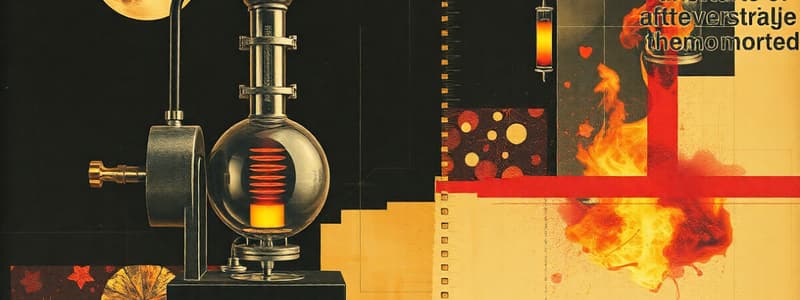Podcast
Questions and Answers
What is the primary purpose of a bomb calorimeter?
What is the primary purpose of a bomb calorimeter?
- To measure the energy of large-scale reactions (correct)
- To convert chemical energy into electrical energy
- To measure pressure changes in reactions
- To measure the temperature changes of gases
Heat loss is significant in a bomb calorimeter.
Heat loss is significant in a bomb calorimeter.
False (B)
What constant is used in the formulas to calculate enthalpy change in a bomb calorimeter?
What constant is used in the formulas to calculate enthalpy change in a bomb calorimeter?
C
The enthalpy change ($ ext{ΔH}$) can be calculated using the formula $\text{ΔH} = -C \Delta ______$.
The enthalpy change ($ ext{ΔH}$) can be calculated using the formula $\text{ΔH} = -C \Delta ______$.
Match the components of a bomb calorimeter with their functions:
Match the components of a bomb calorimeter with their functions:
Which of the following is NOT a requirement for calorimetry?
Which of the following is NOT a requirement for calorimetry?
The specific heat capacity is the amount of heat required to change the temperature of a substance by one degree Celsius.
The specific heat capacity is the amount of heat required to change the temperature of a substance by one degree Celsius.
What does ΔH represent in a chemical reaction?
What does ΔH represent in a chemical reaction?
In calorimetry, the formula to calculate the heat absorbed or released is Q = mass × specific heat capacity × Δ______.
In calorimetry, the formula to calculate the heat absorbed or released is Q = mass × specific heat capacity × Δ______.
What is the main purpose of a calorimeter?
What is the main purpose of a calorimeter?
A flame calorimeter is used to measure the heat changes during combustion reactions.
A flame calorimeter is used to measure the heat changes during combustion reactions.
Match the following terms with their definitions:
Match the following terms with their definitions:
What component in a simple calorimeter helps to minimize heat loss?
What component in a simple calorimeter helps to minimize heat loss?
A bomb calorimeter consists of a cylindrical metal vessel that contains the sample being tested and is surrounded by _______ to absorb heat.
A bomb calorimeter consists of a cylindrical metal vessel that contains the sample being tested and is surrounded by _______ to absorb heat.
Match the following types of calorimeters with their main features:
Match the following types of calorimeters with their main features:
What does the enthalpy change of a reaction (${ΔH}$) represent?
What does the enthalpy change of a reaction (${ΔH}$) represent?
In simple calorimetry, it is assumed that Styrofoam is a perfect insulator.
In simple calorimetry, it is assumed that Styrofoam is a perfect insulator.
What is the relationship between the heat absorbed or released (Q) and the enthalpy change ($ΔH$) in an exothermic reaction?
What is the relationship between the heat absorbed or released (Q) and the enthalpy change ($ΔH$) in an exothermic reaction?
In calorimetry, 1.0 mL of water is equivalent to _____ grams.
In calorimetry, 1.0 mL of water is equivalent to _____ grams.
Match the calorimetry variables with their definitions:
Match the calorimetry variables with their definitions:
What is the primary purpose of a calorimeter in cooking?
What is the primary purpose of a calorimeter in cooking?
A calorimeter is 100% efficient in measuring heat energy.
A calorimeter is 100% efficient in measuring heat energy.
What does ΔH represent in calorimetry?
What does ΔH represent in calorimetry?
The formula for calculating enthalpy change is ΔH = - (Q_{pot} + Q_{____}).
The formula for calculating enthalpy change is ΔH = - (Q_{pot} + Q_{____}).
What does the Zeroth Law of Thermodynamics state?
What does the Zeroth Law of Thermodynamics state?
The First Law of Thermodynamics states that energy can be created as long as it is transferred to another form.
The First Law of Thermodynamics states that energy can be created as long as it is transferred to another form.
In calorimetry, a _____ system is used, meaning matter and energy cannot leave or enter.
In calorimetry, a _____ system is used, meaning matter and energy cannot leave or enter.
Match the laws of thermodynamics to their definitions:
Match the laws of thermodynamics to their definitions:
What does the efficiency formula use as input?
What does the efficiency formula use as input?
Efficiency is calculated by dividing output by input and multiplying by 100%.
Efficiency is calculated by dividing output by input and multiplying by 100%.
What is the symbol for efficiency in the efficiency formula?
What is the symbol for efficiency in the efficiency formula?
The variable Q represents the output, which can be calculated using the ________ of the material being heated.
The variable Q represents the output, which can be calculated using the ________ of the material being heated.
Match the variable with its description in the efficiency formulas:
Match the variable with its description in the efficiency formulas:
Flashcards
Zeroth Law of Thermodynamics
Zeroth Law of Thermodynamics
Heat always moves from a hotter object to a colder object.
First Law of Thermodynamics
First Law of Thermodynamics
Energy cannot be created or destroyed, it can only change forms.
Thermochemistry
Thermochemistry
The study of energy changes in chemical reactions.
Calorimeter
Calorimeter
Signup and view all the flashcards
Calorimetry
Calorimetry
Signup and view all the flashcards
Calorimetry Assumption 1
Calorimetry Assumption 1
Signup and view all the flashcards
Calorimetry Assumption 2
Calorimetry Assumption 2
Signup and view all the flashcards
Calorimetry Assumption 3
Calorimetry Assumption 3
Signup and view all the flashcards
Calorimetry Assumption 4
Calorimetry Assumption 4
Signup and view all the flashcards
What is the relationship between enthalpy change and heat change?
What is the relationship between enthalpy change and heat change?
Signup and view all the flashcards
Specific heat capacity
Specific heat capacity
Signup and view all the flashcards
Temperature change (ΔT)
Temperature change (ΔT)
Signup and view all the flashcards
Enthalpy (ΔH)
Enthalpy (ΔH)
Signup and view all the flashcards
Heat energy (ΔQ)
Heat energy (ΔQ)
Signup and view all the flashcards
Simple calorimeter: What is it?
Simple calorimeter: What is it?
Signup and view all the flashcards
Flame calorimeter: What is it?
Flame calorimeter: What is it?
Signup and view all the flashcards
Bomb calorimeter: What is it?
Bomb calorimeter: What is it?
Signup and view all the flashcards
Why is a styrofoam cup used in a simple calorimeter?
Why is a styrofoam cup used in a simple calorimeter?
Signup and view all the flashcards
Why is water used in a bomb calorimeter?
Why is water used in a bomb calorimeter?
Signup and view all the flashcards
Bomb Calorimeter
Bomb Calorimeter
Signup and view all the flashcards
Ignition Wire
Ignition Wire
Signup and view all the flashcards
Bomb Calorimeter Constant (C)
Bomb Calorimeter Constant (C)
Signup and view all the flashcards
Enthalpy Change (ΔH)
Enthalpy Change (ΔH)
Signup and view all the flashcards
Molar Enthalpy Change (nHm)
Molar Enthalpy Change (nHm)
Signup and view all the flashcards
Enthalpy change
Enthalpy change
Signup and view all the flashcards
Heat absorbed by the pot ($Q_{pot}$)
Heat absorbed by the pot ($Q_{pot}$)
Signup and view all the flashcards
Heat absorbed by the water ($Q_{water}$)
Heat absorbed by the water ($Q_{water}$)
Signup and view all the flashcards
Efficiency
Efficiency
Signup and view all the flashcards
Input (Energy)
Input (Energy)
Signup and view all the flashcards
Output (Energy)
Output (Energy)
Signup and view all the flashcards
Specific Heat Capacity (c)
Specific Heat Capacity (c)
Signup and view all the flashcards
Molar Enthalpy (Hm)
Molar Enthalpy (Hm)
Signup and view all the flashcards




